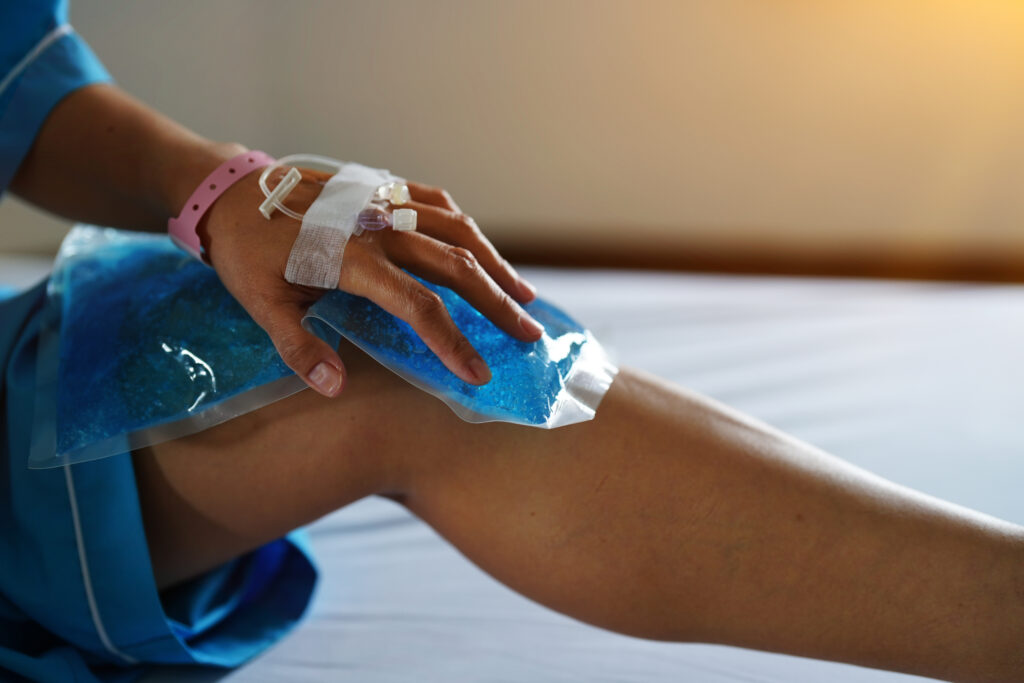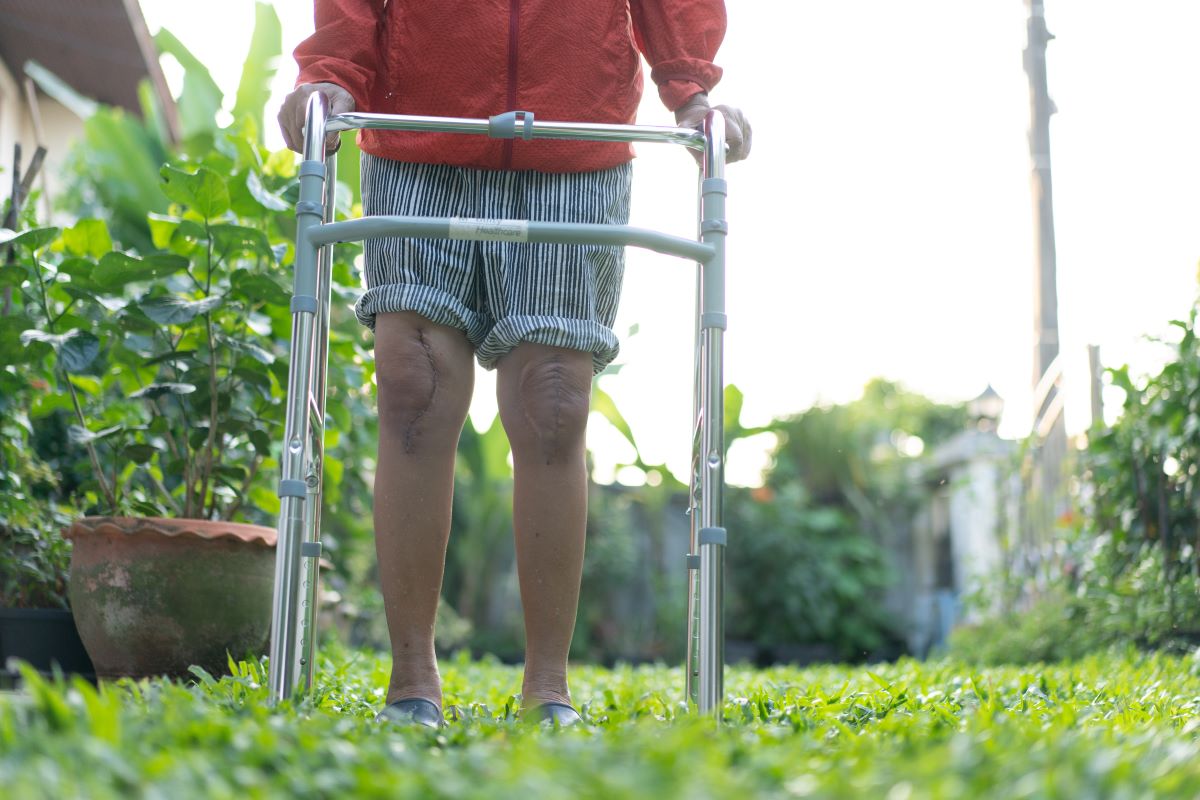How to Get the Best Sleep After Knee Replacement Surgery
Sleep is so important after any surgery to allow your body to heal.
However, getting comfortable and sleeping after a knee replacement surgery can be a huge challenge.
For me, the first few nights after having my left knee replaced were some of the most restless I’ve ever experienced.
Between the pain, stiffness, and new limitations with range of motion, it was a real struggle just to get settled, let alone stay asleep for more than a few hours at a time.
Those sleepless nights were so frustrating.
Thankfully, after a little trial and error, I was able to start sleeping for longer periods of time within the first couple weeks.
So, stick around, and I’ll share the tips and tricks that helped me get the rest I needed for recovery, from sleep position and pillow placement to medication timing.
Whether you just had surgery or it was a while ago, I hope you find something here that helps you get a more restful night’s sleep after knee replacement.
Why Sleep is So Important After a Total Knee Replacement Surgery
Did you know that sleep deprivation can slow down the healing process?
It can!
A good night’s sleep can have a huge effect on your body’s ability to heal after a total knee replacement.
Here are a few reasons that sleep is so important after surgery:
Helps with Healing
When you sleep, your brain is hard at work.
It produces hormones that promote tissue growth, repair your blood vessels, and speed up wound healing.
Sleep also increases the production of white blood cells, which are important for fighting off viruses and bacteria.

Offers Your Body a Break
Sleeping helps your mind and your heart to take a break.
Your blood pressure goes down while you sleep, giving your heart a rest.
Sleeping also makes your body release good hormones that help you relax and heal faster.
Helps With Pain
Good quality sleep after joint replacement surgery can really help with decreasing discomfort.
It reduces inflammation, helps your body fight off illness, and makes your blood flow better.
It also calms your nerves, so you feel less stressed and heal faster.
Pain Management Strategies
There are several pain management strategies that you can try after total knee arthroplasty so that you can sleep.
Here are a few:
1. Use Ice to Reduce Swelling
Swelling is a common problem after knee replacement surgery, and it can cause pain and discomfort.
Applying ice to your surgery site can help decrease swelling, which in turn can decrease pain and improve your sleep quality.
You can use ice packs, a bag of frozen peas wrapped in a towel or an ice machine (cryocuff). I personally used the cryocuff, the effects seemed to last much longer.
You will want to apply the ice to your knee for about 20 minutes at a time. Be sure not to put the ice directly on your skin, use a towel in between.
Use the ice several times a day, and be sure that you do this just prior to going to bed.

2. Take Pain Medication Before Bedtime
Taking your pain medication routinely for the first 1-2 weeks after surgery can be very helpful.
If you don’t take your pain medicine as scheduled, your pain can become severe – it then becomes harder to get it under control again.
Your orthopedic surgeon will also order an anti-inflammatory medication that you should also take for mild to moderate pain.
This will help to keep your swelling down and will, in turn, help with your pain control.
When your pain is under control, you can sleep more comfortably.
Try to schedule your pain pills so that you can take them 30-60 minutes before you plan to go to bed – this can help you stay asleep longer by reducing nighttime pain.
3. Elevate the Leg
Elevating the surgical leg can help decrease swelling, which can help reduce pain and improve your sleep quality.
It can also help with blood flow, which can also promote healing.
You can prop your leg up with pillows or a wedge pillow that is made to elevate the knee.
4. Take the Naps
During the early recovery period, some people feel that they should avoid napping because it can affect the way they sleep at night.
But trust me, with or without napping, sleeping throughout the night will be difficult due to pain and stiffness – so take the naps!
Getting some rest, regardless of whether it is during the day or at night, is important. I think that I only survived because of napping.
Don’t worry, you will get back to your normal sleep pattern when the pain and swelling decrease.
5. Practice Good Sleep Hygiene
Good sleep hygiene is important for anyone, but it becomes especially important when your recovering from knee replacement surgery.
Make sure your sleeping area is comfortable.
Keep the room quiet, cool, and dark. You may want to consider wearing an eye mask to keep the area dark, especially if you’re napping.
Stop using electronic devices and bright screens before bedtime.
And stick to a bedtime routine to help you create a healthy sleep pattern.

6. Use Supportive Devices
Using supportive devices while sleeping can help decrease pain and discomfort after knee surgery.
Here are a few options:
- Knee pillows can help keep your knees aligned and decrease pressure on your knees while sleeping on your side and back. You can also use a regular flat pillow.
- Body Pillow – If you are having difficulty finding a comfortable sleeping position after your knee replacement surgery, try using a body pillow. Body pillows can help support your leg and keep you from putting pressure on your knee. They can also help keep your spine in the proper position while you sleep.
- An adjustable bed can help you find the perfect sleeping position and provide support for your knees, but I’m not sure I would rush out and buy one since you will be back to your normal sleep pattern in a fairly short amount of time. But you do you.
7. Physical Activity
Try to stay physically active throughout the day – this will help to make you more tired at bedtime.
On the days you don’t have physical therapy, be sure to do your home exercises and some gentle exercise like walking or stationary cycling.
This can improve your circulation and reduce stiffness.

8. Relaxation techniques
Practicing relaxation techniques, like deep breathing or meditation, can help reduce stress and promote relaxation, which can also help with pain management.
Sleep Positions After Knee Surgery
Here is a list of safe sleeping positions and helpful devices that you can use to get a good night’s sleep.
Safe Sleeping Postures
Sleeping was a real struggle the first few weeks.
I had a difficult time resting in my bed – I just couldn’t get in a comfortable position!
But I found that propping myself up in the recliner or on the couch with pillows worked much better.
It was so much cozier and allowed me to actually get some rest.
I just kept moving back and forth between the couch and recliner to find comfort wherever I could.
The good news is that by the third week after your total joint replacement, you should be able to return to sleeping in your bed.
However, you will need to find the best position that won’t cause damage to your new knee.
Here are some safe and recommended sleeping positions:
Side Sleeping
This was the best sleeping position for me – you will want to sleep on your non-operative side.
It’s a really good idea to place a thin pillow or knee pillow between your legs.
This will help to keep your hips in neutral position so that the top knee doesn’t fall forward and out of alignment causing increased knee pain. It also helps to keep pressure off of the knees.
Lying on Your Back
This is another great position – you will want to place a pillow under the back of your knee and lower leg to keep your leg elevated above the heart and in alignment.
The pillows can help decrease swelling and give your knee proper support.
Sleeping on Your Stomach
I will say that this was the most uncomfortable position for me.
It caused too much pressure on my surgical site.
It also caused the leg to fully extend, which is very painful after knee surgery.
If you continue to struggle with finding the best way to get some sleep -, reach out to your physical therapist or orthopedic surgeon to see if they can suggest some different alternatives for better sleep.
Conclusion
I understand that having a total knee replacement can be overwhelming, but with these tips and tricks, you should have the information you need for a better night’s sleep.
Remember, every person’s recovery journey is different, so don’t get frustrated if things don’t go as smoothly as you had hoped.
It’s important to listen to your body and make adjustments based on what works best for you.
Don’t forget about practicing good sleeping posture, using supportive pillows, and elevating your leg to reduce swelling.
I also want to stress the importance of staying active during your recovery period.
With regular movement and exercise recommended by your medical team, you can strengthen the muscles around your new knee joint and improve flexibility.
This will not only help with a smoother recovery but will also help you get better sleep by decreasing your pain and discomfort.
Recovering from a total knee replacement surgery may seem like an uphill battle at times, just know that it will get better every day as long as you put in the work.
Be patient with yourself and celebrate every small victory along the way.
I hope this has been helpful in providing some useful tips and tricks for sleeping after total knee replacement surgery.
Remember to take care of yourself mentally and physically during this time, get enough rest when needed but also keep pushing yourself towards a full recovery.
As always, I wish you the best of luck on your journey towards a healthier, happier knee!

Thank you for all this . I’m having a total knee replacement (left knee) 1/15. I’m a little worried . I’ve not been under for 16 yrs .
Good luck! Ice and therapy are very important. Just follow the MD and therapist recommendations and I’m sure you will do well!
Thanks for the useful tips. I have done bilateral total knee replacement. My orthopedic surgeons used AI tools with X-ray to get the exact figure of the deformity and assessed the measurement to carry out the surgery and fitment of implant.